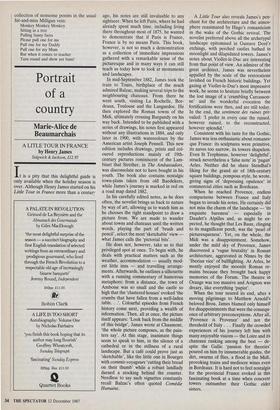Portrait of a country
Marie-Alice de Beaumarchais
A LITLE TOUR IN FRANCE by Henry James
Sidgwick & Jackson, £12.95
It is a pity that this delightful guide is only available when the holiday season is over. Although Henry James started on his Little Tour in France more than a centur- ago, his notes are still invaluable to any sightseer. When he left Paris, where he had already spent much time, including living there throughout most of 1875, he wanted to demonstrate that if Paris is France, France is by no means Paris. This book, however, is not so much a demonstration as a collection of immediate impressions gathered with a remarkable sense of the picturesque and in many ways it can still teach us today how to look at monuments and landscapes.
In mid-September 1882, James took the train to Tours, birthplace of the much admired Balzac, making several trips to the neighbouring chateaux. From there he went south, visiting La Rochelle, Bor- deaux, Toulouse and the Languedoc. He then explored the Roman towns of the Midi, ultimately crossing Burgundy on his way back. Intended to be published with a series of drawings, his notes first appeared without any illustrations in 1884, and only later in 1900, with watercolours by the American artist Joseph Pennell. This new edition includes drawings, prints and col- oured reproductions mainly of 19th- century pictures reminiscent of the Lam- binet that Strether, in The Ambassadors, was disconsolate not to have bought in his youth. The book also contains nostalgic town-plans taken from old Baedekers, while James's journey is marked in red on a road map dated 1882.
In his carefully edited notes, as he does often, the novelist brings us back to nature by way of art, allowing us to watch him as he chooses the right standpoint to draw a picture from. We are made to wander about towns and chateaux until the written words, playing the part of 'brush and pencil', select the most `sketchable' view— what James calls the 'pictorial bits'.
He does not, however, take us to that privileged spot at once. To begin with, he deals with practical matters such as the weather, accommodation — usually mod- est little inns — and travelling arrange- ments. Afterwards, he outlines a silhouette with a running commentary of humorous metaphors: from a distance, the town of Amboise was so small and the castle so high that the 'clustered houses' evoked 'the crumbs that have fallen from a well-laden table. . .'. Colourful episodes from French history come next, providing a wealth of information. Then, all at once, the picture itself appears: 'Look back from the middle of this bridge', James wrote at Chaumont, `the whole picture composes, as the pain- ters say'. At this stage, inanimate things seem to speak to him, in the silence of a cathedral or in the stillness of a rural landscape. But a café could prove just as `sketchable', like the little one in Bourges with commis-voyageurs 'cutting their bread on their thumb' while a robust landlady darned a stocking behind the counter. Needless to say such vignettes constantly recall Balzac's often quoted Comedie Humaine. A Little Tour also reveals James's pen- chant for the architecture and the atmos- phere reanimated by Hugo's romanticism in the wake of the Gothic revival. The novelist preferred above all the archetypal landscape epitomised in Gustave Dore's etchings, with perched castles bathed in moonlight and dilapidated towers. James's notes about Viollet-le-Duc are interesting from that point of view. An admirer of the great architect, James was nevertheless appalled by the scale of the restorations lavished on French historic buildings. Yet gazing at Viollet-le-Duc's most impressive work, he seems to hesitate briefly between the lost image of a 'crumbling Carcasson- ne' and the wonderful evocation the fortifications were then, and are still today. In the end, the sentiment des ruines pre- vailed: 'I prefer in every case the ruined, however ruined, to the reconstructed, however splendid.'
Consistent with his taste for the Gothic, James was less enthusiastic about romanes- que France: its sculptures were primitive, its naves too narrow, its towers shapeless. Even St Trophimus, however 'delightful', struck nevertheless a 'false note' in 'pagan' Arles. Neither did he share Stendhal's liking for the grand air of 18th-century square buildings, pompous style, he wrote, giving signs of 'depressing opulence' in commercial cities such as Bordeaux.
When he reached Provence, endless comparisons between France and Italy began to invade his notes. He certainly did not miss the charm of the landscape — 'its exquisite bareness' — especially in Daudet's Alpilles and, as might be ex- pected, he thought that Les Baux, clinging to its magnificent perch, was the 'pearl of picturesqueness'. Yet, on the whole, the Midi was a disappointment. Somehow, under the mild sky of Provence, James discovered a 'vague brutality' in Roman architecture, aggravated in Nimes by the `Iberian vice' of bullfighting. At Arles, he mostly enjoyed the moonlit Roman re- mains because they brought back happy memories of the Forum. The theatre in Orange was too massive and Avignon was dreary, like everything 'papist'.
When the tour neared its end, after a moving pilgrimage to Matthew Arnold's beloved Brou, James blamed only himself for disappointments that were the consequ- ence of arbitrary preconceptions. After all, `Provence is Provence' and not the threshold of Italy . . . Finally the crowded experiences of his journey left him with many enjoyable visions — the Loire and its chateaux ranking among the best — de- spite the Gallic 'passion for theories' poured on him by innumerable guides, the dirt, swarms of flies, a flood in the Midi, provoking trains and mediocre wines even in Bordeaux. It is hard not to feel nostalgia for the provincial France evoked in this fascinating book at a time when concrete towers outnumber their Gothic elder sisters.


























































 Previous page
Previous page